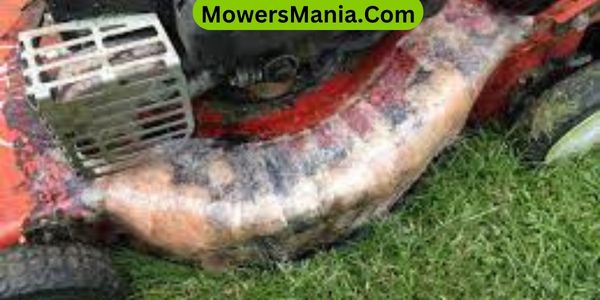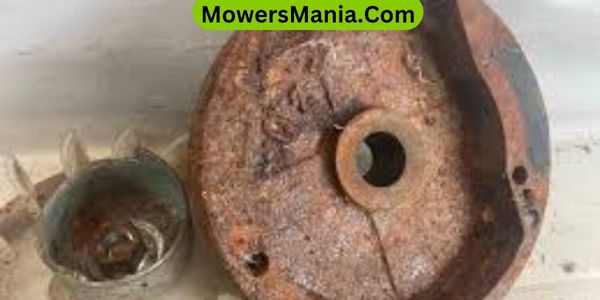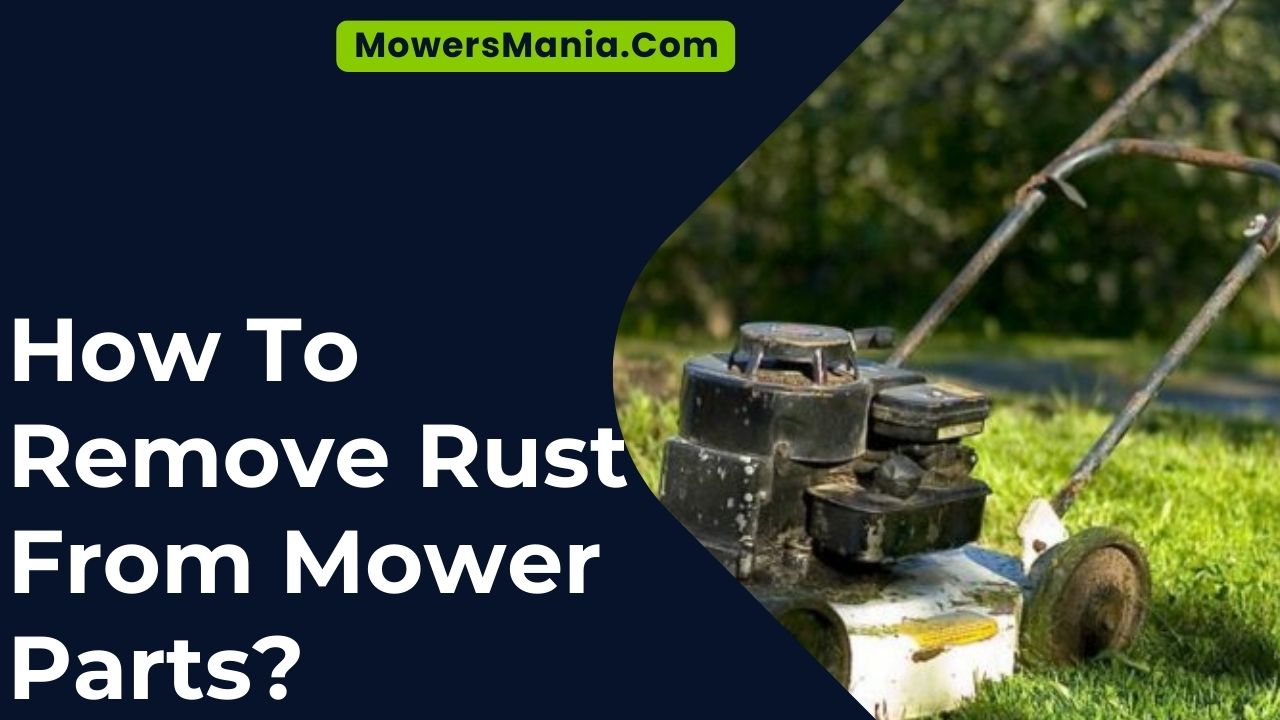When your mower parts start to rust, it’s like a sign that time and neglect have taken their toll. But don’t worry, you can bring those parts back to life.
Removing rust from mower parts is a simple process that can help extend the life of your equipment. With a few basic supplies and some elbow grease, you can have your mower parts looking like new again in no time.

Let’s get started!
Understanding the Rusting Process
When you understand how rust forms on metal surfaces, you can take proactive steps to prevent it from damaging your mower parts.
Rust, scientifically known as iron oxide, is formed when iron or metal alloys containing iron are exposed to oxygen and moisture for extended periods. This exposure leads to a chemical reaction where the iron atoms combine with oxygen to form iron oxide.
The presence of water, especially in the form of humidity or condensation, accelerates this process. Additionally, certain environmental factors such as salt and pollutants can expedite rust formation.
Understanding the rusting process empowers you to implement effective preventive measures.
Regular cleaning and drying of mower parts, especially after use in wet conditions, can significantly reduce the risk of rust formation.
Applying a protective coating, such as paint or rust-resistant sprays, creates a barrier between the metal surface and the surrounding environment, minimizing exposure to oxygen and moisture.
Assessing the Extent of Rust
Assessing the extent of rust on your mower parts can be done by visually inspecting the affected areas for discoloration, pitting, or corrosion.
Look for any red, brown, or orange spots on the metal surfaces. These are signs of rust formation. Pay attention to any areas that appear to have small pits or holes, as this indicates advanced rusting.
Additionally, check for any flaky or powdery residue on the surface, which is a common indicator of corrosion. Use a flashlight to examine hard-to-reach areas or crevices where rust may be present.
It’s important to note that surface rust may only affect the outer layer of the metal, while deeper rust can compromise the structural integrity of the part.
If the rust appears to be widespread or severe, it may be necessary to seek professional assistance or consider replacing the affected parts altogether.
Gathering the Necessary Supplies

You’ll need to gather essential cleaning tools, rust removal products, and the necessary safety gear. These supplies will help you effectively remove rust from your mower parts.
Make sure you have everything on hand before you start the rust removal process.
Essential Cleaning Tools
To effectively remove rust from mower parts, gather the essential cleaning tools needed for the job.
Start by getting a wire brush to scrub off loose rust and dirt.
Next, grab a sandpaper with different grits to smooth out the surface.
You’ll also need a rust remover solution to break down stubborn rust.
Additionally, get a container for soaking small parts in the rust remover.
A sturdy pair of gloves will protect your hands during the cleaning process.
For hard-to-reach areas, a set of small brushes or toothbrushes will come in handy.
Finally, have some clean rags and a lubricant like WD-40 for coating the parts after rust removal.
With these essential cleaning tools, you’ll be well-equipped to tackle rust on your mower parts.
Rust Removal Products
Gather all the necessary supplies for rust removal. Purchase a rust remover solution, wire brush, sandpaper, gloves, small brushes, and a lubricant.
When choosing a rust remover solution, look for one that’s specifically designed for breaking down and removing rust from metal surfaces.
A wire brush will help you scrub away loose rust and dirt.
Sandpaper can be used to smooth the surface after the rust is removed.
Gloves are essential for protecting your hands from the chemicals in the rust remover solution.
Small brushes can help you reach into crevices and tight spots.
Safety Gear Required
You will need to gather the necessary supplies for rust removal, including a rust remover solution, wire brush, sandpaper, gloves, small brushes, and a lubricant.
These items are essential for ensuring your safety and effectively removing rust from mower parts. It is important to prioritize safety by wearing protective gear such as gloves to shield your hands from harsh chemicals and sharp tools.
Additionally, using a lubricant can help loosen rusty parts and make the removal process easier.
Here’s a table summarizing the safety gear required for rust removal:
| Safety Gear | Purpose |
|---|---|
| Gloves | Protect your hands from chemicals |
| Wire brush | Remove loose rust and debris |
| Sandpaper | Smooth rough surfaces |
Gathering these supplies will help you safely and effectively remove rust from mower parts.
Applying Rust Removal Methods

Now it’s time to get down to business and start removing that pesky rust from your mower parts.
Start by soaking the rusty areas in a vinegar solution to help loosen the rust.
Then, use steel wool to scrub away the remaining rust and reveal the shiny metal underneath.
Soaking in Vinegar Solution
To start the rust removal process, begin by filling a container with a 50/50 solution of vinegar and water. Submerge the rusty mower parts in the vinegar solution, ensuring they’re completely covered. Let the parts soak for at least 8 hours or overnight for the best results.
Check the parts periodically and gently scrub off the loosened rust using a brush or steel wool. Once the rust has been removed, thoroughly rinse and dry the parts to prevent any residual vinegar from causing further corrosion.
This method is effective for smaller mower parts and provides an eco-friendly and cost-effective way to eliminate rust.
Scrubbing With Steel Wool
After soaking the rusty mower parts in the vinegar solution, continue the rust removal process by vigorously scrubbing the remaining rust with steel wool, ensuring to cover all affected areas thoroughly.
Use a back-and-forth motion to dislodge the rust, applying moderate pressure as needed. Be mindful not to scrub too hard, as this may damage the metal surface. Once the rust starts to lift, wipe the area with a clean cloth to check the progress.
Repeat the scrubbing process until the rust is completely removed, and then proceed with rinsing and drying the parts. Remember to wear gloves and eye protection while handling the steel wool to avoid any potential irritation or injury.
| Steel Wool Scrubbing Tips |
|---|
| Use medium-grade steel wool |
| Work in a well-ventilated area |
| Apply rust remover if necessary |
| Keep the surface lubricated with water or rust remover |
| Inspect for any remaining rust spots |
Scrubbing and Polishing the Parts
You will need a metal brush or steel wool to effectively scrub and polish the rusted mower parts. Start by scrubbing the parts vigorously with the metal brush or steel wool to remove the surface rust.
Focus on areas with heavy rust buildup, applying firm pressure to break up the rust and reveal the clean metal underneath. Once the rust is removed, use a clean cloth to wipe away any remaining debris.
Next, apply a metal polish to the parts to restore their shine and protect them from future rusting. Use a soft cloth to apply the metal polish in small, circular motions, ensuring that the entire surface is covered. Allow the polish to dry according to the manufacturer’s instructions.
Preventing Future Rust Formation

To prevent future rust formation, regularly apply a protective coating to the mower parts. This will create a barrier between the metal surface and moisture, preventing oxidation and rust.
There are various types of protective coatings available, each with its own benefits and application methods.
Refer to the table below for a comparison of common protective coatings for mower parts:
| Coating Type | Advantages | Application Method |
|---|---|---|
| Oil-based | Provides excellent corrosion resistance | Apply with a brush or spray |
| Wax | Easy to apply and provides a glossy finish | Rub onto the surface |
| Rust inhibitor | Penetrates and neutralizes existing rust | Apply directly onto the rusted areas |
Frequently Asked Questions [FAQs]
Can I Use Household Items Like Vinegar or Baking Soda to Remove Rust From Mower Parts?
You can use household items like vinegar or baking soda to remove rust from mower parts. These options are often effective and easily accessible. Just be sure to follow proper safety precautions and thoroughly rinse the parts afterwards.
Is It Safe to Use a Wire Brush or Sandpaper to Scrub off Rust From Delicate Mower Parts?
Yes, it’s safe to use a wire brush or sandpaper to scrub off rust from delicate mower parts, but be gentle to avoid damaging the surface. Consider using a fine-grit sandpaper and a light touch.
Will Removing Rust From Mower Parts Affect the Overall Performance of the Mower?
Removing rust from mower parts can improve the overall performance. Rust can hinder movement and cause damage over time. With proper rust removal, you can ensure that the mower functions smoothly and efficiently.
Are There Any Specific Safety Precautions I Should Take While Removing Rust From Mower Parts?
When removing rust from mower parts, wear gloves and safety goggles to protect your hands and eyes. Use a well-ventilated area, and avoid inhaling rust particles. Keep a first aid kit nearby in case of minor injuries.
How Often Should I Inspect My Mower Parts for Rust to Prevent Extensive Damage?
Inspect your mower parts for rust every few months. Regular inspection helps prevent extensive damage and ensures your mower remains in good working condition. Catching rust early allows for easier removal and maintenance.
Conclusion
Now that you’ve removed the rust from your mower parts, remember to regularly inspect and maintain them to prevent future rusting.
By keeping your mower parts clean and dry, you can extend their lifespan and keep your mower running smoothly.
With the right supplies and methods, you can easily tackle rust and keep your mower in top condition for years to come.



